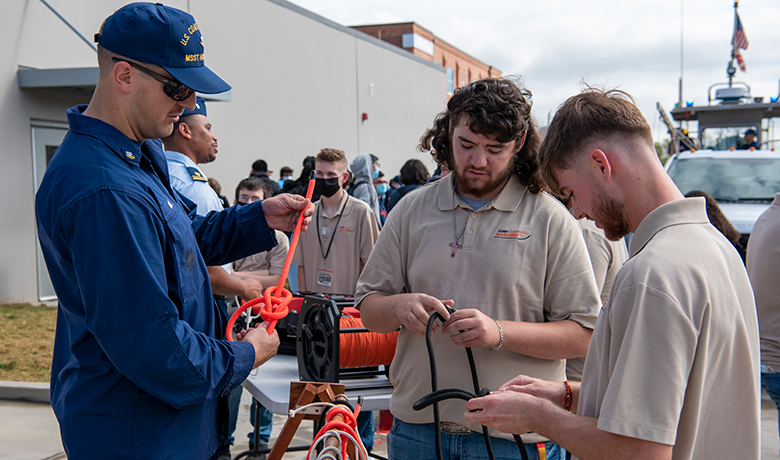
Back when I was a kid, my dad would tell me what it was like working in the merchant marine. He sailed as an able seaman and boatswain, and I loved hearing his tales of working on a tanker off Venezuela, a stick ship in Africa and a freighter in Alaska.
After dad retired, one of his friends who’d heard the same stories asked him to visit his social studies class one afternoon to talk about his maritime career. He happily agreed. My dad showed photos and explained to the high school students what a merchant mariner does, how working on a commercial ship is different from being in the Navy, and the ways our country relies on the merchant marine and the broader maritime industry.
My dad came home after visiting the class and recalled how the students were just as enthralled by his tales as I was. But when answering their questions, it was obvious to him that few of the students had a clue about what the merchant marine was — even after his careful explanations. A fishing boat, battleship and containership were all the same in their minds. And so were the men and women who worked on these very different vessels.
As a mariner, I find it hard to believe that people ashore can’t distinguish between these ships and the work they do. But many of my mariner friends have told me they have experienced the same thing. To their kids and their friends, anything floating on the water falls within the same category — just another boat. I am pleased to report that there are efforts to change this perception among high school students.
During a book tour, I stayed with our friends John and Muriel Olguin in San Pedro, Calif. I was happy when John arranged for me to talk at the nearby Port of Los Angeles High School in San Pedro. While I was brainstorming ideas for the visit, John told me this school is part of a nationwide network of around three dozen maritime high schools, many of which are in port cities such as New Orleans, Houston, Baltimore and Seattle. The full list is available on the U.S. Maritime Administration’s website. This was the first time I had heard of maritime high schools, and I was looking forward to meeting the students and seeing for myself what they knew about my industry.
On the day of my talk, I learned that maritime high school graduates leave with more than a traditional diploma. They also gain a solid understanding of the maritime industry. Along with classroom time focusing on both onshore and offshore aspects of the maritime trade, many such high schools offer internships during the holidays on commercial vessels. Internships can include training where the students learn firsthand how to obtain a TWIC card, an entry-level Merchant Mariner Credential (MMC), and even maritime certification for firefighting, lifeboatman and other endorsements. With such an inclusive education, by the time the students complete high school they know for sure whether a career in the maritime industry is right for them.
A young fellow on my street in Washington could have saved his parents around $75,000 had he gone to a public maritime high school. I heard from his dad that one night at dinner Tony announced out of the blue that he wanted to attend my alma mater, California Maritime Academy. After hearing the news from his parents, I gave Tony a call suggesting that he come by our house for a chat. I wanted to recommend that he let me set him up with a one-week internship at a local tugboat outfit, or take a class at Fremont Maritime in Seattle, or perhaps go with me to visit one of the maritime companies I have worked with to see what they did before making his final decision. But his mind was made up, and he did none of those things. After a traditional high school graduation, Tony went down to California to attend Cal Maritime.
On summer vacation two years later, once again out of the blue, he announced to his parents that the maritime industry was not his future. He had decided to quit Cal Maritime. Since then, he has never had anything to do with the maritime trade. He could have saved his parents a lot of money and saved himself time and effort had he attended a free maritime high school. He would have known before graduating that a career working on the water was not in his for him.
I believe that an expanded network of maritime high schools is essential for our country and for the future of our industry. The government, along with our maritime unions and maritime companies, should pony up the money and expertise to make sure that happens. The average age of U.S. merchant mariners is close to 50, and if we don’t get young people interested in joining our profession, our domestic merchant marine may “die on the vine” along with the benefits it brings us all.
Til next time, I wish you all smooth sailin.’ •
Capt. Kelly Sweeney holds the license of master (oceans, any gross tons) and has held a master of towing vessels (oceans) license as well. He has sailed on more than 40 commercial vessels and lives on an island near Seattle. He can be contacted by email at captsweeney@outlook.com.
